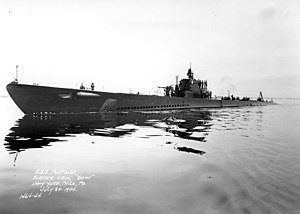United States Porpoise-class submarine

| |
| Class overview | |
|---|---|
| Builders | Electric Boat Company, Portsmouth Naval Shipyard, Mare Island Naval Shipyard[1] |
| Operators | |
| Preceded by | Cachalot class[1] |
| Succeeded by | Salmon class[1] |
| Built | 1933–1937[2] |
| In commission | 1935–1945[2] |
| Completed | 10[1] |
| Active | 0[1] |
| Lost | 4[1] |
| Retired | 6[1] |
| Preserved | 0[1] |
| General characteristics P-1 Type | |
| Type | Diesel-electric submarine |
| Displacement | 1,316 tons surfaced[3] 1,934 tons submerged[3] |
| Length | list error: <br /> list (help) 289 ft (88 m) (waterline) 301 ft (92 m) (overall)[5] |
| Beam | 24 ft 11 in (7.59 m) [3] |
| Draft | 14 ft 1 in (4.29 m) maximum[3] |
| Propulsion | list error: <br /> list (help) 4 × 16-cylinder Winton 201A diesel engines driving electrical generators[4] 2 × 120-cell Exide batteries[3] |
| Speed | list error: <br /> list (help) 18 knots (33 km/h) surfaced[3] 8 knots (15 km/h) submerged[3] |
| Range | 11,000 nautical miles (20,000 km) surfaced at 10 knots (19 km/h)[3] |
| Test depth | 250 ft (80 m)[3] |
| Complement | 50 [3] -55[6] |
| Armament | list error: <br /> list (help) 6 x 21-inch (533mm) torpedo tubes (four forward, two aft; 16 torpedoes) [3] 1 x 3-inch (76mm) / 50 caliber deck gun[3] 2 x 0.5-inch machine gun 4 x 0.3-inch machine gun |
The Porpoise class were submarines built for the United States Navy in the late 1930s, and incorporated a number of modern features that would make them the basis for subsequent Salmon, Sargo, Tambor, Gato, Balao, and Tench classes. Based on the Cachalots, enlarged to incorporate additional main diesels and generators,[7] the Portsmouth boats were all riveted.[8]
In general, they were around 300 feet (91 m) long and diesel-electric powered. Displacement was 1,934 tons submerged for the first four boats, 1,998 tons for the later ones.
The all-electric drive was troublesome. In this arrangement, the boat's four main diesel engines drove only electric generators, which supplied power to electric motors attached to the propeller shafts. The engines themselves were not connected to the propeller shafts. For submerged propulsion, massive storage batteries supplied electricity to the motors. Problems arose with flashover and arcing in the main motors. There was also a loss of 360 hp (270 kW) in transmission through the electrical system.[9] Their Winton Model 16-201A 16-cylinder diesels also proved problematic, and were eventually replaced with 12-278As.[10]
The Porpoise class consisted of the following subclasses:
P-1 Type
- (SS-172) USS Porpoise
- (SS-173) USS Pike
P-3 Type
- (SS-174) USS Shark
- (SS-175) USS Tarpon
P-5 Type
- (SS-176) USS Perch
- (SS-177) USS Pickerel
- (SS-178) USS Permit
- (SS-179) USS Plunger
- (SS-180) USS Pollack
- (SS-181) USS Pompano
References
- ^ a b c d e f g h Bauer, K. Jack (1991). Register of Ships of the U.S. Navy, 1775–1990: Major Combatants. Westport, Connecticut: Greenwood Press. p. 269. ISBN 0-313-26202-0.
{{cite book}}: Unknown parameter|coauthors=ignored (|author=suggested) (help) - ^ a b Friedman, Norman (1995). U.S. Submarines Through 1945: An Illustrated Design History. Annapolis, Maryland: United States Naval Institute. pp. 285–304. ISBN 1-55750-263-3.
{{cite book}}: Cite has empty unknown parameter:|coauthors=(help) - ^ a b c d e f g h i j k l m n o p Miller, David (2001). The Illustrated Directory of Submarines of the World. London: Greenwich Editions. ISBN 0-86288-613-9.
{{cite book}}: Cite has empty unknown parameter:|coauthors=(help) - ^ Lenton, p.39.
- ^ Lenton, H. T. American Submarines (New York: Doubleday, 1973), p.39.
- ^ Lenton, p.39.
- ^ Alden, John D., Commander, USN (retired). The Fleet Submarine in the U.S. Navy (Annapolis, MD: Naval Institute Press, 1979), p.210.
- ^ Alden, p.210.
- ^ Alden, pp.58 and 65.
- ^ Alden, p.58.
